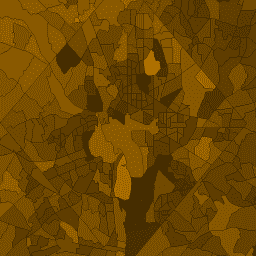
- Dostępność zbioru danych
- 2010-01-01T00:00:00Z–2010-01-02T00:00:00Z
- Dostawca zbioru danych
- United States Census Bureau
- Tagi
Opis
Amerykańskie Biuro Spisu Ludności regularnie udostępnia geobazę danych o nazwie TIGER. Ta tabela zawiera wartości z profilu demograficznego 1 z 2010 r. agregowane według okręgu spisowego. Obszary spisowe bardzo się różnią, ale na obszarach miejskich są w przybliżeniu równoważne dzielnicy. Zawiera około 74 tys. wielokątów obejmujących Stany Zjednoczone, Dystrykt Kolumbii, Portoryko i obszary wyspiarskie.
Szczegółowe informacje techniczne o wszystkich produktach TIGER 2010 znajdziesz w dokumentacji technicznej TIGER.
Każdy okręg zawiera też atrybuty z sumami pomiarów populacji DP1, które przecinają jego granicę. Kolumny mają taką samą nazwę jak kolumna shortname w tabeli wyszukiwania DP1.
Schemat tabeli
Schemat tabeli
| Nazwa | Typ | Opis |
|---|---|---|
| aland10 | LICZBA ZMIENNOPRZECINKOWA O PODWÓJNEJ PRECYZJI | Powierzchnia |
| awater10 | LICZBA ZMIENNOPRZECINKOWA O PODWÓJNEJ PRECYZJI | Obszar wodny |
| geoid10 | CIĄG ZNAKÓW | Identyfikator okręgu spisowego: połączenie kodu FIPS stanu, kodu FIPS hrabstwa i kodu okręgu spisowego. |
| intptlat10 | CIĄG ZNAKÓW | Szerokość geograficzna punktu wewnętrznego |
| intptlon10 | CIĄG ZNAKÓW | Długość geograficzna punktu wewnętrznego |
| namelsad10 | CIĄG ZNAKÓW | Opis obszaru prawnego lub statystycznego oraz nazwa okręgu spisowego |
| shape_area | LICZBA ZMIENNOPRZECINKOWA O PODWÓJNEJ PRECYZJI | Powierzchnia w stopniach kwadratowych |
| shape_leng | LICZBA ZMIENNOPRZECINKOWA O PODWÓJNEJ PRECYZJI | Granica w stopniach |
Warunki korzystania z usługi
Warunki korzystania z usługi
Amerykańskie Biuro Spisu Ludności udostępnia niektóre ze swoich publicznych danych w formacie czytelnym dla maszyn za pomocą interfejsu API. Wszystkie treści, dokumentacja, kod i materiały powiązane udostępniane Ci za pomocą interfejsu API podlegają niniejszym warunkom.
Cytaty
W przypadku tworzenia raportów, publikacji, nowych zbiorów danych, produktów pochodnych lub usług na podstawie zbioru danych użytkownicy powinni cytować US Census Bureau.
Odkrywanie za pomocą Earth Engine
Edytor kodu (JavaScript)
var dataset = ee.FeatureCollection('TIGER/2010/Tracts_DP1'); var visParams = { min: 0, max: 4000, opacity: 0.8, }; // Turn the strings into numbers dataset = dataset.map(function (f) { return f.set('shape_area', ee.Number.parse(f.get('dp0010001'))); }); Map.setCenter(-103.882, 43.036, 8); var image = ee.Image().float().paint(dataset, 'dp0010001'); Map.addLayer(image, visParams, 'TIGER/2010/Tracts_DP1'); Map.addLayer(dataset, null, 'for Inspector', false);
Wyświetlanie jako widok cech
FeatureView to przyspieszona reprezentacja FeatureCollection, którą można tylko wyświetlać. Więcej informacji znajdziesz w
FeatureView dokumentacji.
Edytor kodu (JavaScript)
var fvLayer = ui.Map.FeatureViewLayer('TIGER/2010/Tracts_DP1_FeatureView'); var visParams = { opacity: 0.8, color: { property: 'dp0010001', mode: 'linear', palette: ['black', 'white'], min: 0, max: 4000 } }; fvLayer.setVisParams(visParams); fvLayer.setName('US census tracts demographics'); Map.setCenter(-103.882, 43.036, 8); Map.add(fvLayer);
